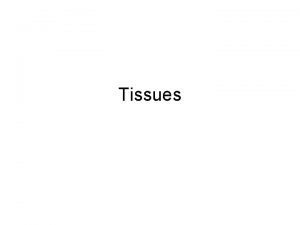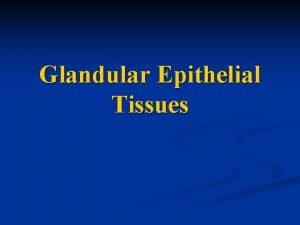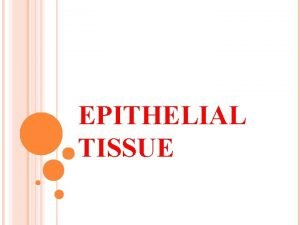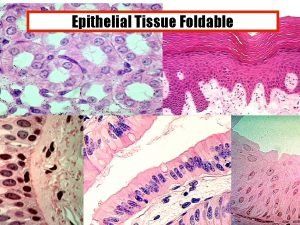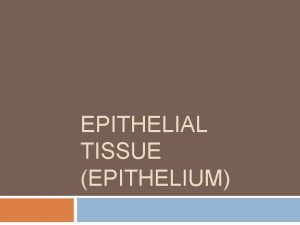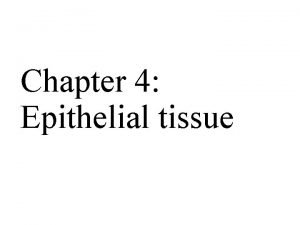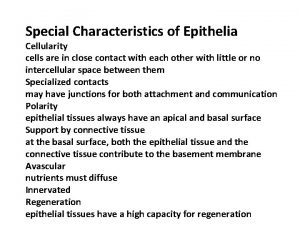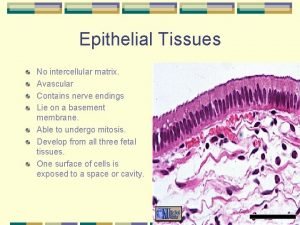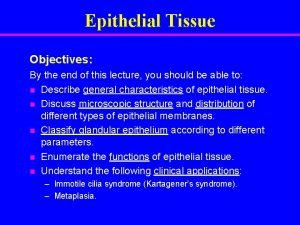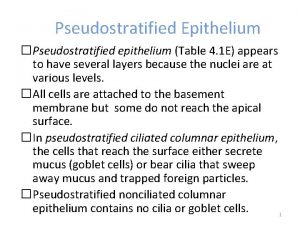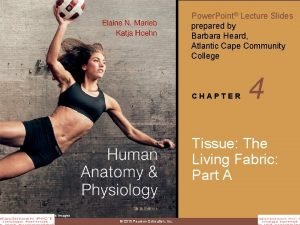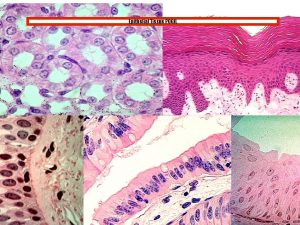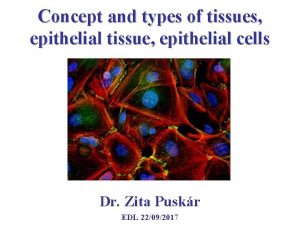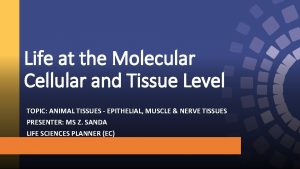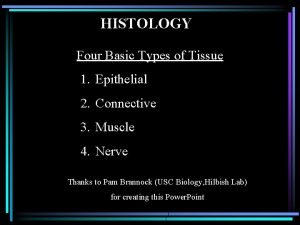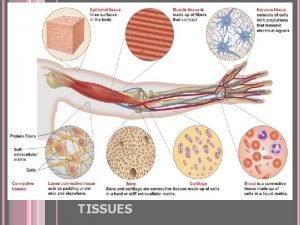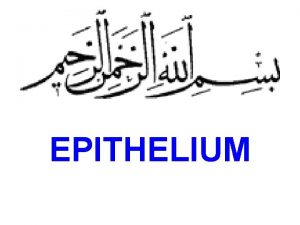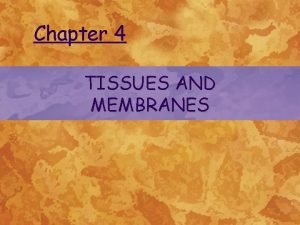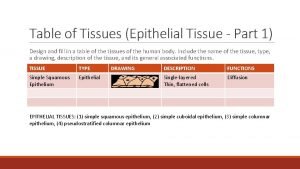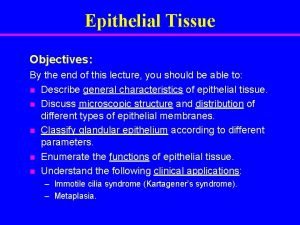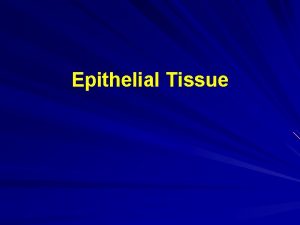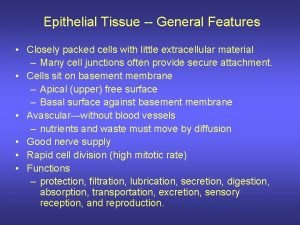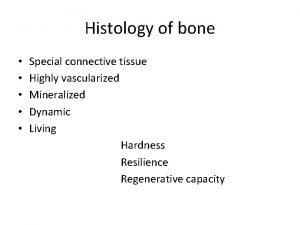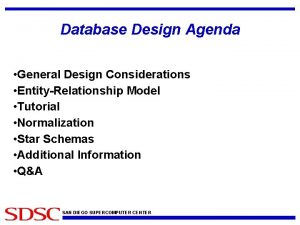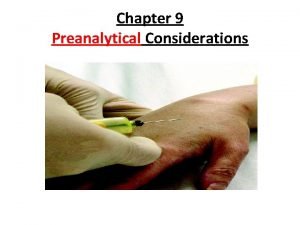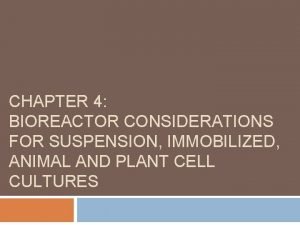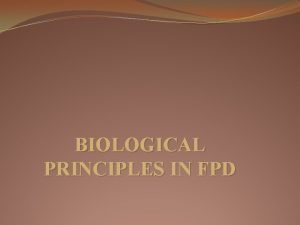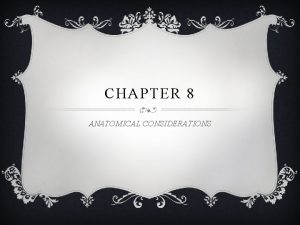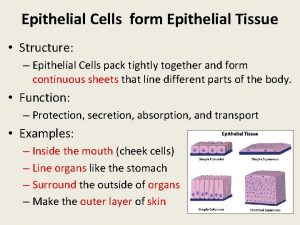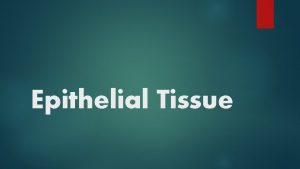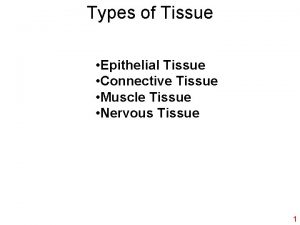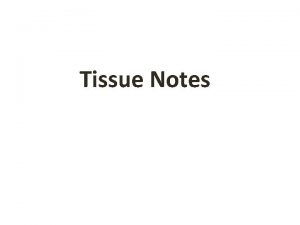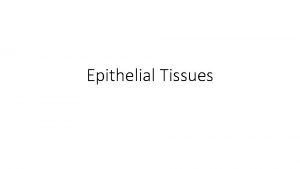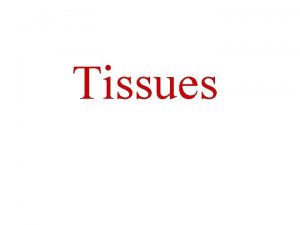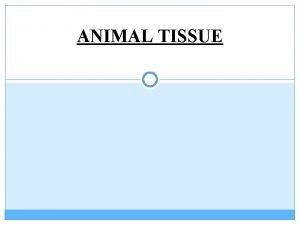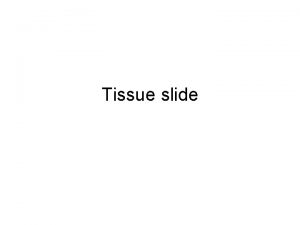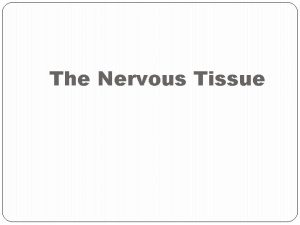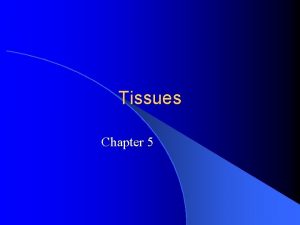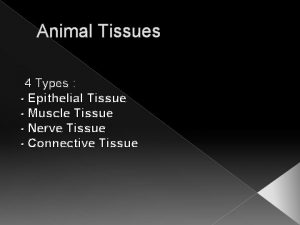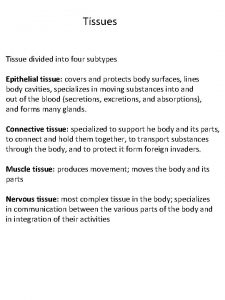Epithelial Tissue I General Features and Considerations A













































- Slides: 45

Epithelial Tissue I. General Features and Considerations

A. Characteristics 1. Lines internal and external surfaces 2. Single or multiple layers of cells 3. Little or no intercellular space 4. Avascular 5. Polarization 6. Keratin 7. Cell junctions 8. Basement membrane

1. Protection

2. Absorption

2. Absorption

3. Secretion

3. Secretion

4. Excretion

5. Sensation

6. Contraction

Epithelial Tissue II. Classification of Epithelia

A. Terminology 1. Classification by number of layers: - simple - stratified 2. Classification by shape of surface cells: - squamous, cuboidal, or columnar 3. Classification by structural specializations: - pseudostratified - transitional (urinary) - surface structures

B. Simple epithelia 1. Simple squamous 2. Simple cuboidal 3. Simple columnar

Simple Squamous Epithelium

Simple Squamous Epithelium

Endothelium

Mesothelium

Simple Cuboidal Epithelium

Simple Cuboidal Epithelium

3. Simple columnar epithelium a. in profile are rectangular with nuclei usually approximately the same level b. most likely to show polarity c. often function in absorption, secretion or both d. may show extensive surface specializations such as cilia and microvilli e. “pseudostratified” columnar - all cells touch the basement membrane (so it’s “simple) but all do not reach the free surface so it looks like it is multilayered

Simple Columnar Epithelium

B. Stratified epithelia 1. Stratified squamous epithelium - Non-keratinized - Keratinized 2. Stratified columnar (or cuboidal) epithelium

1. Stratified squamous epithelium a. usually 5 -25 cell layers thick b. cuboidal cells on the basement membrane and squamous cells at free surface c. found on surfaces subject to injury, wear & tear d. non-keratinized - lining inside surfaces - all cells including the surface cells viable - surface cells possess functional nuclei e. keratinized - surfaces exposed to external world - surface cells non-viable and do not possess nuclei - surface cells contain almost only keratin (eosinophilic)

Non-Keratinized Stratified Squamous

Keratinized Stratified Squamous

2. Stratified columnar (or cuboidal) epithelium a. deep cells small, irregularly polyhedral while superficial cells cuboidal or columnar b. located at sites of transition from one type of epithelium to another c. provides more robust lining than a simple type of epithelium

Stratified Columnar Epithelium

D. Specialized epithelia 1. Pseudostratified columnar epithelium 2. Transitional (urinary epithelium)

1. Pseudostratified Columnar a. all cells contact the basement membrane but not all cells reach the free surface b. nuclei aligned at two or more levels

Pseudostratified Epithelium

2. Transitional Epithelium a. b. c. form of stratified epithelium that changes in thickness due to the stretch of the organ it lines when relaxed, the surface cells cuboidal and when distended, the surface cell become more squamous in shape found in organs of the urinary system

Transitional Epithelium

Epithelial Tissue IV. Surface Specializations

A. Microvilli 1. Large numbers on a cell surface constitute a brush or striated border by light microscopy 2. 1. 0 mm X 0. 1 mm evaginations of the luminal plasmalemma

A. Microvilli 3. 4. 5. Composed of actin filaments, terminal web extends into cytoplasm Usually covered with a glycocalyx (sugar coat) Functions - increase surface area for absorption

Microvilli

Stereocilia

B. Cilia 1. Actively motile evaginations of luminal plasmalemma, 2 -10 mm long

B. Cilia 2. Core of longitudinal microtubules called an axoneme (9+2) 3. Basal bodies a. at base of cilia b. nine triplet microtubules 4. Function in transport

Cilia

Epithelial Tissue V. Basal Lamina

A. Components 1. Acellular supportive structure that can be up to 100 nm thick 2. Composed mainly of type IV collagen, laminin, and proteoglycans

B. Basement membrane vs. basal lamina

Basement Membrane vs. Basal Lamina

C. Functions 1. Barrier and support 2. Contains recognition and regulatory factors 3. Carries a positive charge - thromobogenic
 Layers of epithelial tissue
Layers of epithelial tissue Epithelial tissue
Epithelial tissue Glandular epithelial tissue
Glandular epithelial tissue Basal membrane
Basal membrane Epithelial tissue histology pogil
Epithelial tissue histology pogil Epithelial tissue
Epithelial tissue Zonula occludens
Zonula occludens Cell shape
Cell shape Cellularity of epithelial tissue
Cellularity of epithelial tissue Epithelial tissue avascular
Epithelial tissue avascular Characteristics of epithelial tissue
Characteristics of epithelial tissue Histology smooth muscle
Histology smooth muscle Ciliated columnar epithelial tissue
Ciliated columnar epithelial tissue Ciliated columnar epithelial tissue
Ciliated columnar epithelial tissue Epithelial tissue histology pogil
Epithelial tissue histology pogil Epithelial tissue
Epithelial tissue Voluntary muscles
Voluntary muscles Epithelial tissue
Epithelial tissue Four basic types of animal tissue
Four basic types of animal tissue Epithelial tissue
Epithelial tissue Pseudostratified columnar epithelium
Pseudostratified columnar epithelium Exoepithelial
Exoepithelial What tissue forms membranes
What tissue forms membranes Stratified epithelial tissue
Stratified epithelial tissue Epithelial tissue table
Epithelial tissue table Epithelial tissue
Epithelial tissue Histology
Histology Filtration epithelial tissue
Filtration epithelial tissue Is epithelial tissue highly vascularized
Is epithelial tissue highly vascularized What are the general considerations in machine design
What are the general considerations in machine design Jaringan epitel dapat ditemukan di
Jaringan epitel dapat ditemukan di Writing strategies and ethical considerations
Writing strategies and ethical considerations Ethical considerations in experimental research
Ethical considerations in experimental research Pricing considerations and approaches
Pricing considerations and approaches Tax considerations for setting up a new business
Tax considerations for setting up a new business Software architecture of atm machine
Software architecture of atm machine Exchange transaction and relationship in marketing
Exchange transaction and relationship in marketing Mechanical design of transmission line
Mechanical design of transmission line Database design considerations
Database design considerations Compare and contrast first and second language acquisition
Compare and contrast first and second language acquisition Cloud delivery model
Cloud delivery model Pre-analytical considerations in phlebotomy
Pre-analytical considerations in phlebotomy Bioreactor considerations for animal cell culture
Bioreactor considerations for animal cell culture Collaboration design considerations
Collaboration design considerations Taper in fpd
Taper in fpd Anatomical considerations
Anatomical considerations
